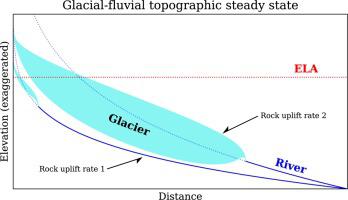当前位置:
X-MOL 学术
›
Earth Planet. Sci. Lett.
›
论文详情
Our official English website, www.x-mol.net, welcomes your
feedback! (Note: you will need to create a separate account there.)
A glacial buzzsaw effect generated by efficient erosion of temperate glaciers in a steady state model
Earth and Planetary Science Letters ( IF 4.8 ) Pub Date : 2020-08-01 , DOI: 10.1016/j.epsl.2020.116350 Günther Prasicek , Stefan Hergarten , Eric Deal , Frédéric Herman , Jörg Robl
Earth and Planetary Science Letters ( IF 4.8 ) Pub Date : 2020-08-01 , DOI: 10.1016/j.epsl.2020.116350 Günther Prasicek , Stefan Hergarten , Eric Deal , Frédéric Herman , Jörg Robl

|
Abstract Studies on relief and hypsometry in glaciated mountain ranges have recognized the equilibrium line altitude of glaciers as a major control on mountain height. This has led to the belief that, in contrast to fluvial topography, glacial topography is limited by climate, with tectonics playing a secondary role. This concept is known as the glacial buzzsaw. However, the understanding of controls on glacial relief has remained mainly qualitative, in part because a reference scenario for glacial landscape evolution — a glacial topographic steady state linked to the base level by a fluvial topographic steady-state downstream of the glacier terminus - and its dependencies have not yet been defined. Here we define such a reference and compare steady state longitudinal profiles in a coupled system of glacial and fluvial erosion that involves both tectonics and climate. Our model is based on the stream power law for fluvial erosion, the shallow ice approximation in combination with a glacial erosion rule, and an empirically determined drainage area-flow length relationship for both rivers and glaciers. Further, we introduce a new approach to incorporate dendritic glacier network structures into the one-dimensional model. Modeling of coupled glacial-fluvial steady-state profiles with empirical glacial and fluvial erosion parameters shows that the difference between glacial and fluvial relief depends on climate, tectonics and the applied erosion laws. Our results imply that glacial erosion can typically balance tectonic uplift rates at lower relief and topographic slopes than fluvial erosion. This steady state equivalent of the glacial buzzsaw effect suggests that glaciers may indeed be more efficient erosional agents than rivers increasing erosion in a cooling climate.
中文翻译:

稳态模型中温带冰川有效侵蚀产生的冰川圆锯效应
摘要 冰川山脉的地势和高度测量研究已经认识到冰川的平衡线高度是山高的主要控制因素。这导致人们相信,与河流地形相反,冰川地形受气候限制,构造作用次要。这个概念被称为冰川电锯。然而,对冰川起伏控制的理解仍然主要是定性的,部分原因是冰川景观演变的参考情景——冰川地形稳定状态通过冰川终点下游的河流地形稳定状态与基准面相连——及其依赖项尚未定义。在这里,我们定义了这样一个参考,并在涉及构造和气候的冰川和河流侵蚀耦合系统中比较了稳态纵向剖面。我们的模型基于河流侵蚀的河流幂律、浅冰近似与冰川侵蚀规则相结合,以及经验确定的河流和冰川的流域-流量长度关系。此外,我们引入了一种将树枝状冰川网络结构纳入一维模型的新方法。使用经验冰川和河流侵蚀参数对耦合的冰川-河流稳态剖面进行建模表明,冰川和河流起伏之间的差异取决于气候、构造和应用的侵蚀规律。我们的结果表明,与河流侵蚀相比,冰川侵蚀通常可以在较低的地势和地形坡度下平衡构造抬升率。这种与冰川电锯效应等效的稳态表明,与在冷却气候中增加侵蚀的河流相比,冰川可能确实是更有效的侵蚀剂。
更新日期:2020-08-01
中文翻译:

稳态模型中温带冰川有效侵蚀产生的冰川圆锯效应
摘要 冰川山脉的地势和高度测量研究已经认识到冰川的平衡线高度是山高的主要控制因素。这导致人们相信,与河流地形相反,冰川地形受气候限制,构造作用次要。这个概念被称为冰川电锯。然而,对冰川起伏控制的理解仍然主要是定性的,部分原因是冰川景观演变的参考情景——冰川地形稳定状态通过冰川终点下游的河流地形稳定状态与基准面相连——及其依赖项尚未定义。在这里,我们定义了这样一个参考,并在涉及构造和气候的冰川和河流侵蚀耦合系统中比较了稳态纵向剖面。我们的模型基于河流侵蚀的河流幂律、浅冰近似与冰川侵蚀规则相结合,以及经验确定的河流和冰川的流域-流量长度关系。此外,我们引入了一种将树枝状冰川网络结构纳入一维模型的新方法。使用经验冰川和河流侵蚀参数对耦合的冰川-河流稳态剖面进行建模表明,冰川和河流起伏之间的差异取决于气候、构造和应用的侵蚀规律。我们的结果表明,与河流侵蚀相比,冰川侵蚀通常可以在较低的地势和地形坡度下平衡构造抬升率。这种与冰川电锯效应等效的稳态表明,与在冷却气候中增加侵蚀的河流相比,冰川可能确实是更有效的侵蚀剂。









































 京公网安备 11010802027423号
京公网安备 11010802027423号